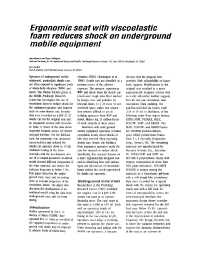Mining Publication: Ergonomic Seat With Viscoelastic Foam Reduces Shock on Underground Mobile Equipment
Original creation date: June 1997
Operators of underground mobile equipment, particularly shuttle cars, are often exposed to significant levels of whole-body vibration (WBV) and shock. The Human Factors group at the NIOSH-Pittsburgh Research Center has investigated the use of viscoelastic foam to reduce shock for the equipment operator and improve seats on mine shuttle cars. In-mine data were recorded on a JOY 21 SC shuttle car for the original seat and an ergonomic version with viscoelastic foam. A review of the data shows improved isolation across the driver/seat pad interface. For the full-load case, the ergonomic seat decreased transmissibility and isolated the shuttle car operator down to 15 Hz. Additional testing of the foam materials with the development and use of a lumped-parameter analytical model showed different composites of the foam materials can reduce the isolation frequency to below 5 Hz. This paper describes the underground mine trials and the testing done to evaluate properties of the viscoelastic foams. The paper also discusses the development of an analytical model using the data from underground trials and the foam testing.
Authors: AG Mayton, S Gallagher, R Merkel
Conference Paper - June 1997
NIOSHTIC2 Number: 20023381
In: B. Das; W. Karwoski, eds., Advances in Occupational Ergonomics and Safety II, IOS Press and Ohmsha, 1997 Jun; :177-180
See Also
- Acceleration and GPS Data Monitor Truck-Haulage Jolts
- Comfort Evaluation for Mine Shuttle Car Seat Designs
- Improved Seat Reduces Jarring/Jolting for Operators of Low-Coal Shuttle Cars
- Investigation of Ampacity Derating Factors for Shuttle Cars Using Fiber Optics Technology
- Laboratory Investigation of Seat Suspension Design Performance during Vibration Testing
- Physiological Responses and Subjective Discomfort of Simulated Whole-Body Vibration From a Mobile Underground Mining Machine
- Shock Reduction for Low-Coal Shuttle Car Operators Using Viscoelastic Seating Foam
- Systematic Comparison of Different Seats on Shuttle Cars Used in Underground Coal Mines
- Whole-Body Vibration and Postural Stress among Operators of Construction Equipment: A Literature Review
- Whole-Body Vibration Exposure Comparison of Seat Designs for Low- and Mid-Seam Shuttle Cars in Underground Coal Mines
- Page last reviewed: 11/17/2015
- Page last updated: 11/17/2015
- Content source: National Institute for Occupational Safety and Health, Mining Program


 ShareCompartir
ShareCompartir
